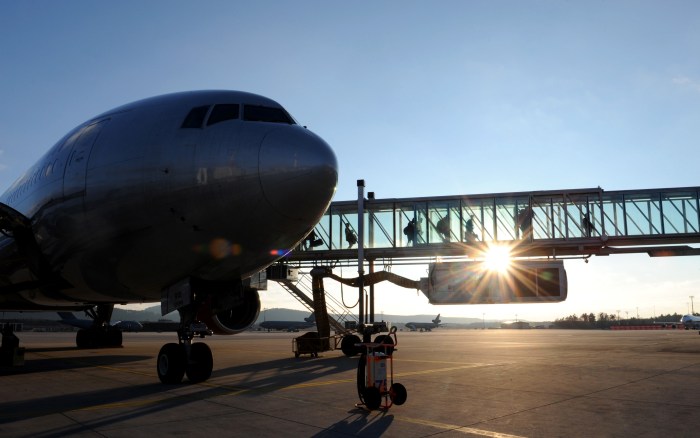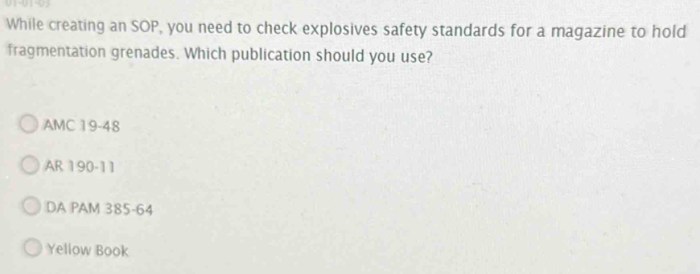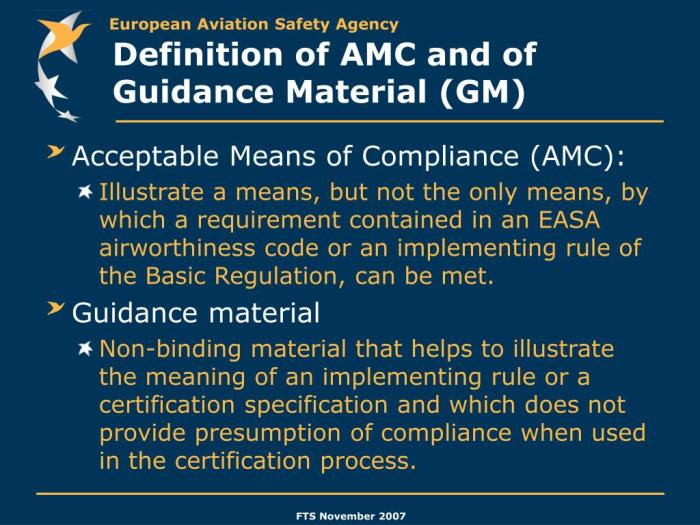Use amc 19-48 for guidance on – As the industry standard for aircraft maintenance and operations, AMC 19-48 provides a comprehensive framework to ensure safety, compliance, and efficiency. In this article, we will delve into the key aspects of AMC 19-48 and explore its practical applications.
AMC 19-48 serves as a valuable resource for aircraft maintenance organizations, guiding them in establishing and maintaining effective maintenance programs. It Artikels specific regulations and standards, promotes continuous improvement, and facilitates data analysis and reporting.
Regulations and Compliance: Use Amc 19-48 For Guidance On

AMC 19-48, a critical document issued by the Federal Aviation Administration (FAA), serves as a comprehensive guide for ensuring compliance with industry best practices and safety regulations in aviation maintenance.
This document meticulously Artikels specific regulations and standards that aviation maintenance technicians (AMTs) must adhere to when performing maintenance, alteration, or inspection tasks on aircraft and related components.
Purpose of AMC 19-48
The primary purpose of AMC 19-48 is to establish clear guidelines and standards that AMTs must follow to maintain the airworthiness and safety of aircraft. By adhering to these regulations, AMTs can ensure that aircraft are maintained in a manner that meets or exceeds the minimum safety requirements established by the FAA.
Specific Regulations and Standards
AMC 19-48 encompasses a wide range of regulations and standards that AMTs must comply with. These include, but are not limited to:
- FAA regulations (14 CFR Parts 43, 65, 145, and 147)
- Advisory Circulars (ACs) and Airworthiness Directives (ADs)
- Manufacturer’s maintenance manuals and service bulletins
- Industry best practices and standards
Compliance with Industry Best Practices, Use amc 19-48 for guidance on
AMC 19-48 plays a vital role in ensuring that AMTs follow industry best practices. By adhering to the regulations and standards Artikeld in this document, AMTs can:
- Maintain aircraft to the highest levels of safety and airworthiness
- Reduce the risk of accidents and incidents
- Increase the efficiency and effectiveness of maintenance operations
- Protect the public and the environment
Aircraft Maintenance and Inspection

AMC 19-48 serves as a vital guide for aircraft maintenance and inspection procedures. It provides standardized guidelines, ensuring consistent execution of maintenance tasks.
Role in Maintenance and Inspection
AMC 19-48 establishes comprehensive guidelines for aircraft maintenance and inspection, covering various aspects such as:
- Maintenance schedules and intervals
- Inspection techniques and procedures
- Repair and replacement procedures
By adhering to AMC 19-48, maintenance personnel can ensure that aircraft are maintained in accordance with industry standards, promoting safety and reliability.
Maintenance Schedules
AMC 19-48 provides guidance on creating and managing maintenance schedules for aircraft. It Artikels:
- Scheduled maintenance tasks and their frequency
- Unscheduled maintenance tasks and their triggers
- Recordkeeping and documentation requirements
Maintenance schedules based on AMC 19-48 help ensure that aircraft are maintained on a regular basis, reducing the likelihood of unexpected failures and enhancing overall safety.
When seeking guidance on wordly wise book 7 lesson 13 , it’s prudent to refer to AMC 19-48 for comprehensive insights. The guidance provided in AMC 19-48 offers a structured framework for understanding the nuances of the topic, ensuring a thorough and well-informed approach.
Safety Management System (SMS)

The integration of AMC 19-48 into a Safety Management System (SMS) is crucial for enhancing the overall safety of aircraft operations. This comprehensive regulation provides a structured framework for identifying, assessing, and mitigating risks, promoting a proactive approach to safety management.
AMC 19-48 contributes significantly to risk assessment and mitigation by establishing a systematic process for hazard identification, risk analysis, and risk control. It guides organizations in developing and implementing safety risk management programs that identify potential hazards, evaluate their likelihood and severity, and develop appropriate mitigation measures.
Integration into SMS
Integrating AMC 19-48 into an SMS involves several key steps:
- Reviewing and understanding the requirements of AMC 19-48.
- Mapping the regulation’s elements to the existing SMS framework.
- Developing and implementing procedures to ensure compliance with AMC 19-48.
- Training personnel on the new requirements and processes.
- Regularly auditing and reviewing the SMS to ensure its effectiveness.
Continuous Improvement
AMC 19-48 fosters continuous improvement in aircraft maintenance and operations by providing a structured framework for evaluating and enhancing maintenance programs. It facilitates the adoption of industry best practices and advancements, ensuring that maintenance and inspection activities are aligned with the latest safety standards and technological developments.
Review and Update Process
AMC 19-48 undergoes regular review and updates to reflect the evolving nature of the aviation industry. This process involves collaboration between industry experts, regulatory authorities, and maintenance organizations. Feedback from operators, manufacturers, and other stakeholders is gathered and analyzed to identify areas for improvement and incorporate industry advancements.
Benchmarking Maintenance Programs
AMC 19-48 serves as a benchmark for evaluating the effectiveness of maintenance and inspection programs. By comparing their practices against the guidelines Artikeld in AMC 19-48, organizations can identify areas for improvement and enhance their overall safety performance.
Training and Personnel Qualifications

AMC 19-48 plays a pivotal role in ensuring that aircraft maintenance personnel are adequately trained and qualified to perform their duties safely and effectively. The manual provides comprehensive guidance on developing training programs that meet the specific requirements of aircraft maintenance tasks.
Training Program Development
AMC 19-48 Artikels the steps involved in developing effective training programs. These include identifying the knowledge and skills required for each maintenance task, developing training objectives, selecting appropriate training methods, and evaluating the effectiveness of the training. The manual emphasizes the importance of using a variety of training methods, including classroom instruction, hands-on practice, and computer-based training.
Personnel Qualification
AMC 19-48 establishes criteria for qualifying aircraft maintenance personnel. These criteria include the minimum level of education, experience, and training required for each type of maintenance task. The manual also provides guidance on maintaining personnel records and ensuring that personnel are up-to-date on the latest maintenance procedures and regulations.By
following the guidance provided in AMC 19-48, organizations can develop and implement training programs that ensure that their aircraft maintenance personnel have the necessary knowledge and skills to perform their tasks safely and effectively.
Data Analysis and Reporting

AMC 19-48 emphasizes the significance of data analysis and reporting for effective maintenance and inspection practices. It establishes guidelines for collecting, analyzing, and disseminating data to enhance decision-making and improve safety outcomes.
AMC 19-48 requires organizations to establish a comprehensive data analysis and reporting system that enables them to:
- Collect and store maintenance and inspection data from various sources, including aircraft logs, maintenance records, and inspection reports.
- Analyze data to identify trends, patterns, and areas for improvement in maintenance and inspection processes.
- Disseminate data to relevant stakeholders, including maintenance personnel, managers, and regulatory authorities, to support decision-making and improve safety.
Data Quality and Decision-Making
AMC 19-48 provides guidance on ensuring data quality and using data effectively for decision-making:
- Data Validation:Organizations should implement processes to validate the accuracy and completeness of data before analysis.
- Data Analysis Techniques:AMC 19-48 recommends using appropriate data analysis techniques, such as statistical analysis and trend analysis, to extract meaningful insights from data.
- Decision-Making:Data analysis should inform decision-making related to maintenance and inspection activities, such as scheduling maintenance tasks, allocating resources, and implementing corrective actions.
Case Studies and Best Practices

AMC 19-48 has been widely adopted by aircraft maintenance organizations to enhance their maintenance and inspection processes. Here are some notable case studies and best practices:
One prominent case study involves a major airline that implemented AMC 19-48 across its entire maintenance operation. The airline reported significant improvements in:
- Maintenance efficiency and reduced turnaround times
- Enhanced safety and compliance
- Optimized resource allocation and reduced costs
Best Practices for Using AMC 19-48
To effectively utilize AMC 19-48, maintenance organizations should consider the following best practices:
- Conduct a thorough gap analysis to identify areas where the organization’s current practices align or deviate from AMC 19-48 requirements.
- Develop a comprehensive implementation plan that Artikels the steps, resources, and timelines for adopting AMC 19-48.
- Provide comprehensive training to all personnel involved in maintenance and inspection activities to ensure a thorough understanding of AMC 19-48 requirements.
- Establish a robust system for monitoring and evaluating the effectiveness of AMC 19-48 implementation, including regular audits and performance reviews.
- Continuously review and update maintenance and inspection procedures to ensure they remain aligned with the latest revisions of AMC 19-48 and industry best practices.
Optimizing AMC 19-48 for Specific Aircraft Types or Operating Environments
To optimize the use of AMC 19-48 for specific aircraft types or operating environments, organizations should:
- Consider the unique characteristics of the aircraft, such as its size, complexity, and operating conditions.
- Review the maintenance and inspection requirements specific to the aircraft type and operating environment.
- Identify areas where AMC 19-48 can be tailored to address the specific needs and challenges of the aircraft and operating environment.
- Develop customized maintenance and inspection procedures that align with AMC 19-48 requirements while addressing the specific requirements of the aircraft and operating environment.
FAQ Corner
What is the purpose of AMC 19-48?
AMC 19-48 provides a comprehensive framework for aircraft maintenance and operations, ensuring compliance with industry best practices and enhancing safety.
How does AMC 19-48 contribute to safety management?
AMC 19-48 integrates with Safety Management Systems (SMS), facilitating risk assessment, mitigation, and enhancing safety reporting and incident investigation processes.
What role does AMC 19-48 play in training and personnel qualifications?
AMC 19-48 Artikels requirements for training and qualifying aircraft maintenance personnel, ensuring they possess the necessary knowledge and skills to perform maintenance tasks safely and effectively.